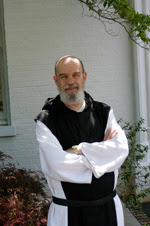Regular readers – and I know there are one or two out there – may have noticed my absence last week. Tuesday morning, I finished throwing a few things into my Travelpro and dragged it out to a cab and headed for LaGuardia and, ultimately, Conyers, Georgia. There, I spent four days at the Monastery of the Holy Spirit, a Trappist house blessed with an abbey church that no less a figure than Flannery O’Connor once described as “incredible.” It is, as the picture above shows.
I did the usual things one does on a monastic retreat: got up for 4 a.m. vigils, chanted the psalms, walked the grounds, took pictures of geese, and ate meals fortified with abundant amounts of beans. I’ve decided this is why monasteries sit on thousands of acres of empty land: after dinner, everyone needs room to walk around and just fart.
Anyway…
I spent a fair amount of time with my good friend James Stephen Behrens (a.k.a. “Jeff”), a gifted writer and homilist and, lately, a very talented photographer, as well.  Jeff has written for places like the National Catholic Reporter and Notre Dame magazine, and has published several books of engaging and deeply human essays – meditations that manage to find miracles among the mundane. His newest book, a collection of photographs and short reflections called “Portraits of Grace,” raises that observational gift to the level of art. Everything from flower pots to abandoned tires to crumpled leaves is charged with “the grandeur of God.” Jeff’s message: the things we toss aside or neglect are to be prized, for they have stories to tell and grace to impart. It’s a beautiful work.
Jeff has written for places like the National Catholic Reporter and Notre Dame magazine, and has published several books of engaging and deeply human essays – meditations that manage to find miracles among the mundane. His newest book, a collection of photographs and short reflections called “Portraits of Grace,” raises that observational gift to the level of art. Everything from flower pots to abandoned tires to crumpled leaves is charged with “the grandeur of God.” Jeff’s message: the things we toss aside or neglect are to be prized, for they have stories to tell and grace to impart. It’s a beautiful work.
Since I managed to time my visit around All Saints Day, I got to see the monks more at play than at work. Jeff invited me to join them in the cloistered refectory for a big feast day bash: an elegant meal (by monk standards) of shrimp, fish, salad and assorted cheesecakes and fudge, plus plentiful beer and wine and – most significantly – free-flowing conversation.
Normally, the monks eat their mid-day meal in silence, listening to holy reading; but for feast days, they’re allowed to table hop and talk. I got to chat with a friend of Jeff’s, Brother Augustine, (below) who is from Chicago and was excited to meet me because for years he has carried a tiny torch for Katie Couric. I promised to get him an autographed picture.
That night, at dinner, one of the monks, Fr. Anthony, invited me to assist him the next morning at a private mass. For All Souls, priests can offer up to three masses, and Anthony was planning to celebrate two before joining the monks in the abbey church for the main liturgy at 7 a.m. So around 4:30 (yes, 4:30 a.m.) I met up with him in the sacristy, grabbed an alb and a priest’s stole and a safety pin (they couldn’t find a purple deacon stole for me) and followed Anthony into the crypt chapel, deep below the main church. There, we set up the altar and the two of us took a deep breath and started the mass. No congregation, no music, very little light. Anthony said the prayers; I read the gospel and offered the responses; 15 minutes later, it was done, and Anthony offered the final blessing — turning to bestow it on the only other person in the chapel, me.
Then he said, “Okay, now let’s do the second one,” and we set up the altar and started all over again. It was a remarkable experience for this new deacon — and surprisingly moving.
After that, I went back to my room and dozed for an hour or so. I rejoined the monks for the main mass at 7:00 a.m. Daylight was starting to seep through the stained glass windows of the abbey church, and there were a couple dozen visitors sitting in the rear of the church, apart from the monks. Another first: I was invited to proclaim the gospel in that “incredible” church, and to join the 20 or so monks circling the altar in the sanctuary for the Eucharistic prayer. After mass, we walked to the graveyard outside, where the abbot blessed each grave with holy water and incense.
It was a ceremony, like so many in a monastery, done with little fanfare, but with tremendous feeling. And meaning. As the abbot walked among the graves and said the names, I watched the monks huddled outside, some wearing sweaters against the November chill. And I realized: this is their story. This is what they were and what they will be. As they hear the names and recall the lives of the men resting there, they are not only recalling and praying over their past; they are also glimpsing their own future. Some of them must have thought: “Someday, the name he says will be mine.”
A few hours later, I was sitting on an AirTran flight bound back to New York — rested and renewed, grateful to have spent even just a little time with men whose only goal is to live simply, pray deeply, and give it all to God.
Life is good.
And, to quote the title of one of Jeff’s books, “Grace is everywhere.”

